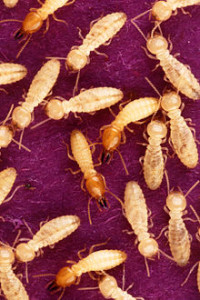Identifying signs of termite infestation.
Guest Post by Hubert Dwight

photo from Wickipaedia
One of the worst nightmares for homeowners is to find that their home is being attacked by termites.
The thought of termites terrorizing your home is enough to send shivers up your spine.
If you are already aware of the damage termites can do to your home, you have every right to have a sense of fear in knowing what extent damage from their presence can do.
If not, then buckle up as we inform you of what termites can do, how they can impact your lifestyle and offer you prevention tips to overcome these issues.
Prevention Is Better Than Cure.
Before going into detail about managing termite infestations, we recommend that you take as much action as possible, such as undergoing Termite Treatments to prevent any infestations.
The cost to resolve the impact from termites can be in the thousands depending on the extent of the damage.
Below are a few ways you can prevent your home from being infested from termites.
Building Design
The way the building is designed can reduce the risk of infestation to the home. This includes:
- Reducing the amount of timber that is used in buildings.
- Using properly designed concrete slabs with edges exposed.
- Installing a reticulated system under the concrete slab that allows chemical barriers to be applied and reapplied when necessary.
- The use of physical barriers – Such as metal shields, stainless steel mesh or granite chip barriers can all be used to stop termites getting into buildings.
- The use of chemical barriers (termiticides) can kill and remove termites through treated layers of soil under and around concrete slabs and pipes. These termiticides can kill or repel termites and even eliminate the entire colony should the termites take the termiticide back to the nest.
Detecting Termite Infestation.
Detecting a termite colony in or around your home indicates your house is at a serious risk.
The average size of a termite colony will range from 300,000 to over a million termites made up of swarmers, workers, and soldiers that can cause serious damage to your home.
While having thousands or millions of these little critters around your home is dangerous, the termite queen poses an even greater risk as she has the power to multiply the colony substantially as she can lay over one thousand eggs in a day.
These termite eggs don’t just go away after a short amount of time neither as they can survive for up to 50 years.
So even if you take actions to remove nests and infested areas, the queen still has the ability to repopulate the colony to its previous levels if the termite infestation isn’t completely dealt with.
Where Are Common Breeding Grounds For Termites?
Termites often breed in the ground and create tunnel systems in the soil.
The mud tubes that they make connect their colonies underground to food sources such as wood materials from your home.
Some termites also live in water sources such as damp areas or leaky faucets produced by rain.
They prefer to dwell in a place with moisture so they will be able to survive and populate.
Having termites in the house can be quite stressful. They can lead to increased safety and fire hazards within the home.
If things get really bad, they may even force you out of your home as they make their way through your dwelling, room after room, growing into a plague of biblical proportions and it can become a living hell for those people that have to live in it.
You must commit to taking action before it is too late.
You have learned that the way termites are, they keep coming and coming and coming, even if you have removed nests or done some baiting yourself, if the queen still lives or if there is a colonization that hasn’t been found, they can repopulate their lost colonization.
Avoid devastation and take action to identify and combat termite infestations as quickly as possible.
what is comply Australian Standards for Double brick wall?
For termite protection the major document is The Building Code of Australia Volume 2 (available for free download at https://services.abcb.gov.au/NCCOnline/Publications/2015)
Read on from. . . .
3.1.3.2 Installation of termite management systems
(a) A termite management system must comply with the appropriate provisions described in Table 3.1.3.1.
(b) A durable notice must be permanently fixed to the building in a prominent location, such as in a meter box or the like, indicating— (i) the termite management system used; and
(ii) the date of installation of the system; and
(iii) where a chemical is used, its life expectancy as listed on the appropriate authority’s pesticides register label; and
(iv) the installer’s or manufacturer’s recommendations for the scope and frequency of future inspections for termite activity.
The treatment can be by various means including:
Exposed concrete edge
Termimesh
Chemical
This also quotes the Australian Standards